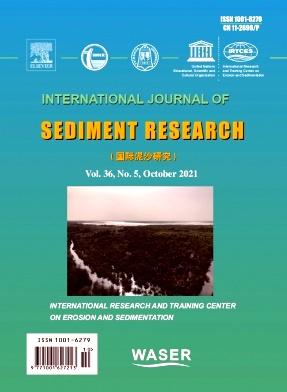Sediment transport modeling for run-of-river hydropower in the Madeira River: Calibration with conventional and remote sensing data
IF 3.7
2区 环境科学与生态学
Q2 ENVIRONMENTAL SCIENCES
引用次数: 0
Abstract
This study aims to evaluate sediment transport processes in the Madeira River, a high-load Amazon tributary altered by the Jirau run-of-river hydropower dam. A methodology for sensitivity analysis and calibration of the HEC-RAS one-dimensional morphodynamic model is developed. It integrates multiple model to measured comparisons, including conventional monitoring and water color remote sensing data. The study underscores the value of employing products derived from satellite imagery, refining model differentiation and improving the spatial and temporal resolution of sediment transport predictions. A simple, regionally significant method of estimating depth-integrated concentrations form surface index concentrations is discussed, showing that for high concentrations a 1.10–2 multiplicative factor suffices. Sensitivity analysis highlights the dominant influence of sand content in the upstream sediment load and the necessity of using the Krone–Partheniades transport formula to simulate fine sediment retention. The calibrated model estimates a sediment retention efficiency of 21.3% in the backwater-affected reach over a five-year period, with over 90% of the sand fraction being deposited. Results suggest that the wash load threshold for this system is medium to coarse silts and clay-silt flocs larger than 0.016 mm. These are the key size classes to understand deposition of fines. Flocculation processes may play a role, requiring adjustments in the input sediment load grain size distribution. A multivariate sediment rating curve, incorporating tributary discharge dynamics, enhances model performance, particularly in reproducing seasonal concentration variations in the backwater reach. These findings provide insights into the best practices for sediment modeling in high-load rivers impacted by hydropower and highlight the importance of multi-objective calibration approaches.
马德拉河顺流水力发电泥沙输运模型:常规和遥感数据校准
本研究旨在评估马德拉河的泥沙运输过程,马德拉河是亚马逊河的一条高负荷支流,被吉劳河径流水电站大坝改变。提出了一种HEC-RAS一维形态动力学模型的灵敏度分析和校正方法。它集成了多个模型来测量比较,包括常规监测和水彩遥感数据。该研究强调了利用卫星图像衍生产品、改进模式区分和提高沉积物输运预测的时空分辨率的价值。讨论了一种简单的、具有区域意义的从地表指数浓度估算深度积分浓度的方法,表明对于高浓度,1.10-2的乘因子就足够了。敏感性分析强调了含沙量在上游泥沙负荷中的主导作用,以及使用Krone-Partheniades输运公式模拟细粒泥沙滞留的必要性。校正后的模型估计,在受回水影响的5年期间,沉积物保持效率为21.3%,超过90%的砂粒被沉积。结果表明,该系统的冲刷负荷阈值为大于0.016 mm的中粗粉砂和粘粉絮体。这些是了解细粒沉积的关键尺寸类别。絮凝作用可能起一定作用,但需要调整输入泥沙粒径分布。包含支流流量动态的多元泥沙等级曲线提高了模型的性能,特别是在再现回水河段的季节性浓度变化方面。这些发现为水电影响下高负荷河流泥沙建模的最佳实践提供了见解,并强调了多目标校准方法的重要性。
本文章由计算机程序翻译,如有差异,请以英文原文为准。
求助全文
约1分钟内获得全文
求助全文
来源期刊
CiteScore
6.90
自引率
5.60%
发文量
88
审稿时长
74 days
期刊介绍:
International Journal of Sediment Research, the Official Journal of The International Research and Training Center on Erosion and Sedimentation and The World Association for Sedimentation and Erosion Research, publishes scientific and technical papers on all aspects of erosion and sedimentation interpreted in its widest sense.
The subject matter is to include not only the mechanics of sediment transport and fluvial processes, but also what is related to geography, geomorphology, soil erosion, watershed management, sedimentology, environmental and ecological impacts of sedimentation, social and economical effects of sedimentation and its assessment, etc. Special attention is paid to engineering problems related to sedimentation and erosion.

 求助内容:
求助内容: 应助结果提醒方式:
应助结果提醒方式:


